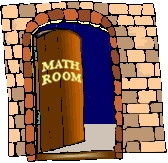


 |
  |
 |
 |
 |
 |
 |
 |
 |
 |
MathRoom Method
Turn Yourself into a Math Whiz
The MathRoom Lessons were written in conversational manner -- as if a teacher were at the chalkboard, teaching you the lesson. Because of this, they work best when they enter your brain through your ears as well as through your eyes -- since that's where you input conversation. If used correctly, the material in these lessons can be triple-saved on the hard drive in your head, so that the memories can be easily accessed from just about any part of your brain. Follow the instructions below to the letter -- consistently -- for one Lesson -- and then test to see if you don't remember the material well. Really, what have you got to lose?
The MathRoom Method
Over many decades of teaching mathematics to both high school and college students I have observed that the majority of students who do well in mathematics do so because they speak math as well as writing it and studying it.
The problem with most math students is that the teacher or the tutor does all the talking, but the students rarely talk the words of mathematics. When one of my students comes in for a lesson and I ask what topic we're covering today, when they first start with me, they usually say " we are covering section 3.2, or section 2.1".
Calling the topics of mathematics section 3.2, or section 2.1 doesn't give you any information about the material in the topic, now does it? However if my student answers " finding the zeros of quadratic functions," then we know exactly what our task is for that hour. If you don't use the vocabulary of the subject, you will never become fluent in the subject. Mathematics is a language, and so should be spoken.
The MathRoom lessons are written in conversational manner. Conversation should be heard. So these lessons should be spoken to you rather than read silently with your eyes from the computer screen.
The human memory is organized very much like the random access memory in your computer. If you create a document and save it in three different folders, when you need to retrieve that document; if one of those folders was accidentally deleted or is somehow out of order, you still have two chances of retrieving your document, don't you?
The same is true for the human memory. If a memory is implanted on my brain in three different ways: by reading it, by speaking it and by hearing it, I have a much better chance of remembering what I said than if I read it silently with my eyes.
This is why the MathRoom Method's first and most important instruction is: Pretend you are a math teacher. Read these files out loud, either to yourself, or to someone else. If you do this, the message enters your mind through your eyes, gets processed into logical thought — then speech — and then it re-enters your brain through your ears. Forgetting the lesson will then take much effort. Besides, you improve your oral reading skills at the same time as you learn math.
The second and equally as important instruction is: NEVER! NEVER! NEVER! PRINT OUT ANY PART OF THESE LESSONS ON PAPER FROM YOUR COMPUTER!!! I have formatted them to empty your color ink cartridge and paper tray in no time at all since all the material is copyrighted and we don't have to kill trees to share this knowledge. When you're studying any of the examples or doing practice questions, write them down by hand rather than clicking a Print icon. As you write them, speak them. If you have to write 5x + 2 = 3, then write it and speak it as well. Now, you're saving the memory files in four different places on the hard drive in your brain because you've added writing to the save process and you're not killing trees.
Instruction number 3: learn and use the names for the operations you perform and the beasties on which you perform those operations. Instead of saying I have to do "this" -- say, "I have to transpose the 5x and then I have to collect like terms." It's like you become the boss of yourself, constantly reminding yourself what to do using math vocabulary.
The final instruction is PRACTICE AS MUCH AS YOU CAN. Do as many examples on a given topic as you need until you know you've grasped the concept and can perform the operations efficiently. Math is a combo of efficiency and precision -- it has to be "short and sweet"-- as simple as possible -- because as you advance, you must be able to perform the basic operations quickly, by instinct rather than conscious thought . Don't overdo it. Practicing something you already know is a waste of time. If you catch on quickly -- 3 or 4 questions will do. Go on to the next topic. On tough stuff, do 10 or 12 questions if you have to. And ask for help when you need it -- not 5 weeks later just before the exam! Math is a continuum. Each new topic builds on the last one so you can't ignore the weak links in the chain for long before the whole thing falls apart.
So, keep up-to-date, keep talkin' math -- and you too will be a Mathster.
TtT
 |
 |
| the mathroom | mathroom mission | mathroom services| mathroom lessons |
| testimonials | meet the mathster | mathroom method | subscription rates |
( all content of the MathRoom Lessons © Tammy the Tutor; 2002 - 2006 )